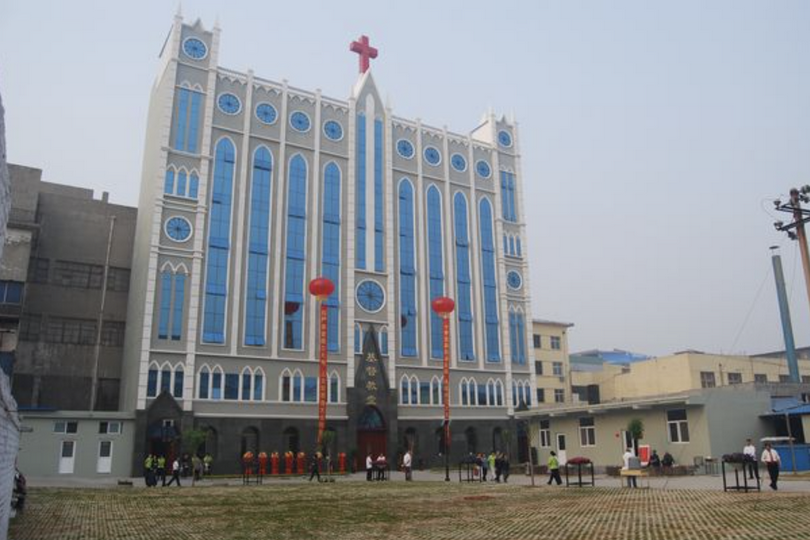At the beginning of the year, I visited a Christian church in Jincheng city, Shanxi Province, to learn about its history and development.
Elder Yan Meiling, vice chairman of Jincheng CC&TSPM and head of the church, received us. At the end of last year, she won the title of the First Advanced Individual in Chinese Religious Circles.
Through the brief introduction at the entrance, we learned that they bought 15.23 mu of land in Xiaodongguan, Jincheng, in 1906 and built the church, school, health clinic, Guangdaocheng photo studio, oil shop, and Beijing goods store successively. Since then, missionary Murray Davies and the "Small Woman" Gladys Aylward have come to work in the church one after another.
In 1924, the health clinic was transformed into Pok Oi Hospital. In 1930, Stanley Smith died of illness, and later his wife contracted sickness when she worked in Yangcheng church and died when she returned to Jincheng. During the Anti-Japanese War, an Englishman, Murray Davis, took over the job and hung the British national flag in the church, which protected many believers and the poor.
At first, the church was reviving, and there were some people from nearby Gaoping, Lingchuan, and Yangcheng who believed in the Lord. Later, the gospel spread to Gaodu, Lucun, Mishan, Yinzhai Shuidong, Liuzhuang, Bagong Donggou, and Taiyang. Most of them were students, workers, and businessmen, and the total number of believers once reached over 400.
Cui Guoping, who used to take drugs and be addicted to gambling, begged to be taken to church. After being baptized, he studied theology and became a pastor. Ma Juxiang, a Gaodu resident who was originally a carpenter, was called to believe in the Lord; his two sons, Ma Baoquan and Ma Baorui, also followed, and they learned photography techniques and did trade business. Li Xinian came to Jincheng after the disaster in his hometown and volunteered to be a coolie when the church was built. His whole family believed in the Lord, and he was also made an elder. His third son studied medicine and later served as the dean of Pok Oi Hospital.
In 1978, the government successively implemented its religious policy, and some old believers lobbied to resume Sunday worship. By Christmas 1982, church activities had officially resumed, and the number of believers continued to increase. In 1987, Li Guangrong searched for relevant information and dared to argue for the ownership of the church property. On June 14th, 1989, the Urban Church was officially opened.
Elder Yan reviewed his experience of serving and church building. She has believed in the Lord with her family since childhood, and her husband's family is also Christian. In 1995, the provincial government held volunteer training and 40 days of systematic Bible training, which made her determined to devote herself to serving God.
She developed the habit of spiritual practice, and the old pastors took her to perform some church procedures. Later, the church set up a church property confirmation team, and then the real estate problem was finally settled. The church received the land certificate before Christmas in 2006.
During the church's construction, all believers actively contributed. There was a believer who worked in a Jincheng coal mine and came to church for worship every week. He dedicated himself every month. When the church was built, he gave half of his salary of RMB 100,000, which exactly met the urgent need for the church building. He lives very frugally. With his determined dedication, his donation was not stopped by his family members.
A Wenzhou brother who worked in Yangcheng and came back from his hometown after the Spring Festival asked how much it cost to build a church. Elder Yan gave her boldest answer, "RMB 50,000." The Wenzhou brother said, "Give me the account number, and I will lend you RMB 300,000 first".
An old sister who was a scavenger and had a mentally retarded son dedicated RMB 1,000, but the mineral water bottle she usually picked up was only worth a few cents. A couple from Fuyang, Anhui, was in Jincheng for a home decoration business. At first, they were not affluent. They borrowed money to make interior decorations for the church, which cost RMB 380,000 and were totally free.
A couple in Northeast China making wrought iron in Jincheng dedicated the wrought iron stairs on both sides of the church from the first to the eighth floors and all the wrought iron of the church and the church compound.
In 2006, Yan Meiling was appointed an elder and served as the head of the church for many years. The church trained and introduced four theology students, and Elder Yan placed hope in them to help them grow.
During the pandemic, the church opened an official WeChat account and published preaching and spiritual articles every day.
Over the years, Jincheng Church has participated in social charity activities such as helping the disabled, students, and poor and preventing pandemic diseases.
In 2003, the church invested one million yuan to set up a "Caring Kindergarten", which solved the school admission difficulties of migrant workers in the old city.
In 2011, the church purchased 515 mu of barren hills in Daji Town, Zezhou County. They installed transformers, built reservoirs, mountainous roads, and dams, with a total investment of nearly three million yuan, for greening purposes.
When the COVID-19 pandemic broke out in 2020, the church mobilized its followers to donate money and materials many times. The church also provided paired-up assistance for Yunnan border areas and supported education.
During the transition, the 57-year-old elder Yan took the initiative to quit the post of president. She said that the church should attach importance to spiritual worker inheritance and give young co-workers a platform for growth.
- Translated by Oliver Zuo












